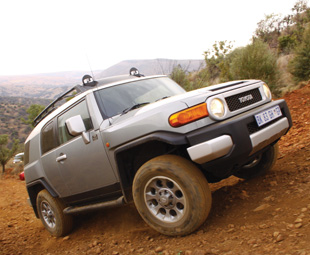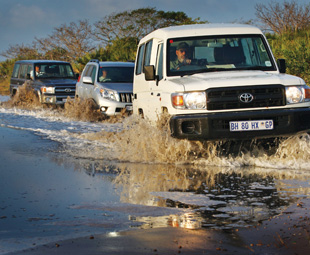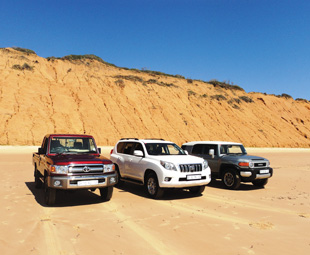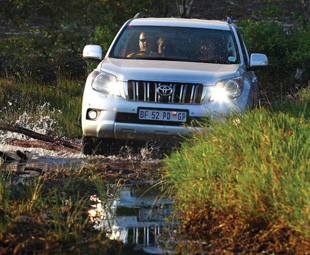Land (Cruiser) ahoy!

1951 was a bad year for babies and a good year for motoring. The first oral contraceptive was invented that year; but so too was the Land Cruiser. CHARLEEN CLARKE jets into Mozambique to celebrate the latter…
“That’s what happens when you drive with an old fart,” reads the sms.
I have received this message because I am up to my eyeballs in mud. Well, my FJ Cruiser test vehicle is. That’s because we’re stuck in a mangrove swamp in the middle of Mozambique, having entered the swamp far too slowly.
The guys over to the right hoot, wave, chortle with glee, gesticulate at their cell phone and drive off – in search of our hotel and cold Laurentina (lest you aren’t aware, this is a sensational brand of beer; its consumption was a hotel-only affair; we never ever drink and drive).
They drive off without compunction, leaving myself and “the old fart” (he is, after all, 76 years old) stranded. The mud is even sneaking over the running board – we are well and truly stuck. My driver – the aforementioned old fart – inches the vehicle forward. No luck. Backwards? It’s equally useless.
Eventually we succumb to that Most Embarrassing of Calls. We get onto the radio and announce that we need help; we need to be towed out of the mud.
On any 4×4 trip, this really is the very last resort; us journos would rather chew mud than get towed out of it. It’s all a matter of pride, you know. Even more so when driving a Land Cruiser. Because, as everyone knows, the Land Cruiser is THE master of Africa! It never, ever, gets stuck! Well, maybe sometimes – as we had just discovered…
We were six hours into the Land Cruiser Armada, an event specially arranged to celebrate the Cruiser’s 60th birthday. We had flown into the rather posh Vilanculos Airport, having dashed into Nelspruit en route, to pick up a passenger or two (it was rather like a bus stop). Now we were heading for Rio Azul, where we would overnight. But first we had to conquer the mangrove swamp, which was rapidly filling with water.
 We had opted to kick off the Armada in the utterly delectable Land Cruiser FJ Cruiser (yes, I know it’s a bit of a mouthful … but that’s its full name). The guys at Toyota tell me that this vehicle is the hooligan of the range; it’s the member of the Land Cruiser family most likely to arrive home late with a new tattoo. And, when the old fart and I eye the FJ Cruiser, we can understand why. It looks like a rebel with a cause – and that cause is to conquer Africa (while simultaneously having loads of fun).
We had opted to kick off the Armada in the utterly delectable Land Cruiser FJ Cruiser (yes, I know it’s a bit of a mouthful … but that’s its full name). The guys at Toyota tell me that this vehicle is the hooligan of the range; it’s the member of the Land Cruiser family most likely to arrive home late with a new tattoo. And, when the old fart and I eye the FJ Cruiser, we can understand why. It looks like a rebel with a cause – and that cause is to conquer Africa (while simultaneously having loads of fun).
We both comment that we adore its chunky, funky lines (its distinctive white roof and squared-off wheel arches get a definite thumbs up); its plush interior; the enormously comfortable seats and the unusual doors (you need to open the front door before opening the rear).
En route to Rio Azul, we also marvel at its road holding and the level of comfort; the roads in Mozambique vacillate from good to shocking and the FJ Cruiser makes mincemeat of the potholes as we make our way north. I’m behind the wheel and I delight in the powerful 4,0-litre V6 petrol engine, fitted with many low friction components and offering 200 kW at 5 600 r/min and 380 Nm at 4 400 r/min. We both agree that the five-speed automatic transmission is super smooth.
But then we change drivers. And encounter the dreaded swamp, which the old fart approaches rather timidly (and, trust me, the man is anything but timid – especially when surrounded by gorgeous ladies or good cigars). As a result, the FJ Cruiser goes into submarine mode and sinks deep, deep into the mud. Even the sophisticated off road-ready advanced traction control (ATRC) cannot rescue us from our plight.
As I bemoan the fact that the old fart has delayed our date with Laurentinas at Rio Azul, a party of rescuers arrives in order to pluck us from the mud. They’re in the Land Cruiser pick-up which, I am told, is a favourite tool of Eskom. Apparently the power company uses the pick-up to hoist power lines. Priced at anything from R382 800 to R408 600, the Land Cruiser pick-up is said to be “the rugged indestructible choice with class leading off-road capabilities” – and it proves its mettle, swiftly extracting us from the mud.
The rest of our drive to the hotel is uneventful – although I do wonder if we are going to make it. The delay has meant that the swamp has turned into a teeming river. “This thing should be equipped with a rudder,” notes the old fart, as we traverse terrain that truly looks impassable. “And a cooler box full of Laurentinas,” I cannot help but add.
An hour later, we arrive at Rio Azul, a luxury beach resort located on the banks of the Govuro River, roughly 80 km north of Vilanculos as the crow flies. The Govuro River runs north from Vilanculos and past Inhassoro and enters the sea at Bartholomew Diaz point, at the northern end of the Bazaruto Archipelago. We are welcomed by Leslie Long, senior manager of market planning at Toyota, who grins as he notes that, “after this afternoon’s excursion, I am sure that you agree that Land Cruiser played a big role in taming Africa”. No kidding.
Long tells us that the Land Cruiser’s ancestry can be traced back to the 1951 BJ Jeep, which was a truck-derived model developed for military use. “The BJ fast proved itself when it became the first vehicle to be driven to the sixth hill station of Japan’s Mount Fuji at a height of 2 500 metres,” he reveals. This feat resulted in the Japanese police adopting the BJ into its fleet, the start of this model’s success.
In 1955 the BJ was supplemented with the 20 Series, a BJ-derived model that was developed to offer more civilian appeal.
The now-ubiquitous low range gearbox was first introduced in the Land Cruiser 40 Series, which was launched in 1960 to replace the 20 Series. “With the introduction of the 40 Series Toyota celebrated 50 000 global sales, but even they could not expect the exponential growth that would follow the LC 40, as it sped ahead to push overall sales past 300 000 a mere five years later,” Long relates.
 It was the 40 Series, and specifically the Land Cruiser FJ-45, that established this brand name in South Africa. First introduced in 1971, one can find many of the originals at Land Cruiser club events and across Southern Africa.
It was the 40 Series, and specifically the Land Cruiser FJ-45, that established this brand name in South Africa. First introduced in 1971, one can find many of the originals at Land Cruiser club events and across Southern Africa.
In 1980 Toyota introduced the 60 Series, still a favourite in Land Cruiser circles, and in 1984 the first of the 70 Series models saw the light. The 70 is still on sale today, which makes it the longest-running model range for Toyota and surely one of the longest-running model ranges in the world of motoring.
The year 1990 saw the introduction of the Land Cruiser 80 Series and in 1996 the Land Cruiser 90 joined the fold. “The 90 Series would become the Prado in later years and it was the first Land Cruiser to feature independent front suspension,” Long explains.
In 1998 the Land Cruiser 100 was introduced. This model is, to this day, a frequent feature on overland trips and at 4×4 competitions. “The 100 was replaced after a decade of success by the Land Cruiser 200, which remains Toyota’s local flagship and the NATO vehicle of choice,” Long reveals.
According to Long, 6,6 million Land Cruisers have now been sold around the world – and it remains a motoring icon.
The next morning, we descend on the local “highway”. I say “highway” because it is, in fact, the beach. It is still legal to drive on the beach in Mozambique and there are only two routes to Rio Azul: via the mangrove swamp (the mangrove estuary system covers an area of around 50 sq km and the waterways of the main and sub-rivers extend for more than a 100 km) or via the beach. Because the beach is a far less tricky option, it’s the route of choice and it’s not unusual to see trucks trundling along the sand.
We have hopped into a FJ Cruiser once again – it’s just so much fun to drive that the old fart and I cannot bear to part ways with it. I kick off the driving in some thick sand and the FJ Cruiser performs faultlessly. At one stage I fear that we will dig in, but we pop it into low range and the vehicle easily conquers the sand.
Then we’re barrelling down the beach, having a blast. We’re driving in a convoy of Land Cruisers – apart from the pick-up there is also a Prado and station wagon in our party – and we comment that the line-up is rather handsome. The same can be said of the interior of our FJ; we admire its upright front windscreen and thin A-pillar, which translate into heaps of interior space; the clever integration of the B-pillar and seat belt anchors into the rear-hinged access doors; and the really funky body-coloured trim elements in the centre console and doors.
All too soon, we have reached Vilanculos, which is where we park the Land Cruisers. Then we hop on a boat, cruise out to Paradise Island (the Survivor TV show was shot there), drink Laurentinas and behave badly. Later we are transported (via boat yet again) to Dugong Beach Lodge, which is situated on the East African seaboard, on the coast of Mozambique and within the boundaries of the Vilanculos Coastal Wildlife Sanctuary. As we arrive at the utterly beautiful lodge – as luxurious as the Land Cruiser 200 – I think I may just have died and gone to heaven…
 The next morning the pampering stops. We are now heading back to the airport – cross country and over a really bumpy, undulating, jutted, hazardous track. The old fart and I walk past the pick-up and head straight for the Land Cruiser Prado. No way in hell are we losing our fillings.
The next morning the pampering stops. We are now heading back to the airport – cross country and over a really bumpy, undulating, jutted, hazardous track. The old fart and I walk past the pick-up and head straight for the Land Cruiser Prado. No way in hell are we losing our fillings.
The journey is punishing – especially to those in the pick-up (we imagine). We’re going as fast as we can, not wanting to miss our flight back to Johannesburg (actually I point out that this would be a rather nice idea … I could think of worse places to be stuck …)
But the Prado is the perfect vehicle for a punishing off-road track; we are cosseted in luxury.
Five hours – and much bundu bashing – later, we arrive at the airport. Another sms arrives. “The Land Cruiser is only 16 years younger than the old fart… but it is in much better nick, hey?”
As we climb onto the plane, I decide that some smses are better left unshared…
THE LATEST RANGE
The Land Cruiser range covers anything and everything – from utilitarian pick-ups to 4x4s with the ride comfort of a limousine.
Land Cruiser 78
Featuring a closed rear cabin with increased space (making for a versatile people carrier or the secure storage of goods) the Land Cruiser 78 is often used as a bush ambulance. It comes with the 1HZ engine – a six-cylinder inline, 4,2-litre diesel, which churns out 96 kW of power at 3 800 r/min and 285 Nm of torque at 2 200 r/min.
Land Cruiser 79
This Land Cruiser pick-up is available with a diesel or petrol engine. The former is the same as described above; the latter is the 1GR-FE, a 4,0-litre, 24-valve, DOHC V6 with VVTi, which boasts 170 kW of power at
5 600 r/min and 360 Nm of torque at 3 800 r/min.
Land Cruiser 76
Offering 230 mm of ground clearance and the ability to transport five people off-road with ease, the Land Cruiser 76 comes with the 1HZ diesel motor.
Land Cruiser FJ Cruiser
The FJ Cruiser features unique rear-hinged access doors that open towards the back to make the FJ a four-door vehicle, but with the styling of a two-door model. It comes with a 4,0-litre V6 petrol engine, which delivers 200 kW of power at 5 600 r/min and 380 Nm of torque at 4 400 r/min.
Land Cruiser Prado
This luxurious off-roader, which offers multi-terrain select with monitor and steering angle display, comes with a choice of two motors: the 1GR-FE petrol or the 1KD-FTV diesel. The latter is a 3,0-litre, four-cylinder, 16-valve DOHC powerplant which delivers 120 kW at 3 400 r/min and 400 Nm at 1 600 to 2 800 r/min.
Land Cruiser 200
The flagship of the Land Cruiser range, the 200 comes with two mighty and powerful engines, the 1VD-FTV (a
4,5-litre V8 diesel) or the 2UZ-FE (a 4,7 V8 petrol). The former churns out 173 kW at 3 200 r/min and 615 Nm at
1 800 to 2 200 r/min. The latter delivers 202 kW at 5 400 r/min and torque of 410 kW at 3 400 r/min.
Land Cruiser 200 60th Edition
With only 60 units of this special edition available, the Land Cruiser 200 60th Edition will soon become a collector’s item. This model is offered with special chrome highlights on the rear number plate garnish, above the side protection mouldings and around the side turn signals. Other exterior highlights include special 60th Edition moulded side steps, and rear bumper/step combination. A number of 60th Edition decals round off the exterior highlights.
Inside this flagship the owner will notice illuminated 60th Edition scuff plates, a special anniversary key casing, 60th Edition emblems and a special tonneau cover.
The Land Cruiser 200 60th Edition is only available in Pearl White metallic with the powerful 4,5-litre V8 turbo diesel engine.
Land Cruiser Prado 60th Edition
Following its LC 200 60th brother, 120 units of the Land Cruiser Prado 60th Edition will be introduced in December 2011. Fitted with the very popular 3,0 D-4D engine, the 60th Edition will feature the TX grade as base, but will include manual transmission, ivory-coloured leather and the option of Pearl White metallic or Graphite Grey metallic as exterior colours.
As with its bigger brother, the Prado 60th Edition boasts unique 60th Edition decals on the exterior, including on the rear spare wheel cover.
Published by
Focus on Transport
focusmagsa



